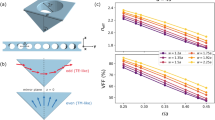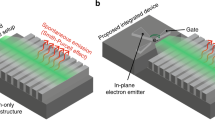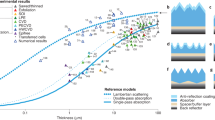Abstract
For optimal energy conversion in photovoltaic devices (electricity to and from light) one important requirement is that the full energy of the photons is used. However, in solar cells, a single electron–hole pair of specific energy is generated when the incoming photon energy is above a certain threshold, with the excess energy being lost to heat. In the so-called quantum-cutting process, a high-energy photon can be divided into two, or more, photons of lower energy. Such manipulation of photon quantum size can then very effectively increase the overall efficiency of a device. In the current work, we demonstrate (space-separated) photon cutting by silicon nanocrystals, in which nearby Er3+ ions and neighbouring nanocrystals are used to detect this effect.
This is a preview of subscription content, access via your institution
Access options
Subscribe to this journal
Receive 12 print issues and online access
$209.00 per year
only $17.42 per issue
Buy this article
- Purchase on Springer Link
- Instant access to full article PDF
Prices may be subject to local taxes which are calculated during checkout



Similar content being viewed by others
References
Shockley, W. & Queisser, H. J. Detailed balance limit of efficiency of p–n junction solar cells. J. Appl. Phys. 32, 510–519 (1961).
Huynh, W. U., Dittmer, J. J. & Alivisatos, A. P. Hybrid nanorod–polymer solar cells. Science 295, 2425–2427 (2002).
Peumans, P., Uchida, S. & Forrest, S. R. Efficient bulk heterojunction photovoltaic cells using small-molecular-weight organic thin films. Nature 425, 158–162 (2003).
O'Regan, B. & Grätzel, M. A low-cost, high-efficiency solar cell based on dye-sensitized colloidal TiO2 films. Nature 353, 737–740 (1991).
Shah, A., Torres, P., Tscharner, R., Wyrsch, N. & Keppner, H. Photovoltaic technology: The case for thin-film solar cells. Science 285, 692–698 (1999).
Wegh, R. T., Donker, H., Oskam, K. D. & Meijerink, A. Visible quantum cutting in LiGdF4:Eu3+ through downconversion. Science 283, 663–666 (1999).
Luque, A., Martí, A. & Nozik, A. J. Solar cells based on quantum dots: Multiple exciton generation in films of electronically coupled PbSe quantum dots. MRS Bull. 32, 236–241 (2007).
Nozik, A. J. Quantum dot solar cells. Physica E 14, 115–120 (2002).
Schaller, R. D. & Klimov, V. I. High efficiency carrier multiplication in PbSe nanocrystals: implications for solar energy conversion. Phys. Rev. Lett. 92, 186601 (2004).
Ellingson, R. J. et al. Highly efficient multiple exciton generation in colloidal PbSe and PbS quantum dots. Nano Lett. 5, 865–871 (2005).
Schaller, R. D., Petruska, M. A. & Klimov, V. I. Effect of electronic structure on carrier multiplication efficiency: Comparative study of PbSe and CdSe nanocrystals. Appl. Phys. Lett. 87, 253102 (2005).
Murphy, J. E. et al. PbTe colloidal nanocrystals: synthesis, characterization, and multiple exciton generation. J. Am. Chem. Soc. 128, 3241–3247 (2006).
Schaller, R. D., Sykora, M., Pietryga, J. M. & Klimov, V. I. Seven excitons at a cost of one: Redefining the limits for conversion efficiency of photons into charge carriers. Nano Lett. 6, 424–429 (2006).
Beard, M. C. et al. Multiple exciton generation in colloidal silicon nanocrystals. Nano Lett. 7, 2506–2512 (2007).
Klimov, V. I., Mikhailovsky, A. A., McBranch, D. W., Leatherdale, C. A. & Bawendi, M. G. Quantization of multiparticle Auger rates in semiconductor quantum dots. Science 287, 1011–1013 (2000).
Hendry, E. et al. Direct observation of electron-to-hole energy transfer in CdSe quantum dots. Phys. Rev. Lett. 96, 057408 (2006).
Fujii, M., Yoshida, M., Kanzawa, Y., Hayashi, S. & Yamamoto, K. 1.54 µm photoluminescence of Er3+ doped into SiO2 films containing Si nanocrystals: Evidence for energy transfer from Si nanocrystals to Er3+. Appl. Phys. Lett. 71, 1198–1200 (1997).
Izeddin, I., Moskalenko, A. S., Yassievich, I. N., Fujii, M. & Gregorkiewicz, T. Nanosecond dynamics of the near-infrared photoluminescence of Er-doped SiO2 sensitized with Si nanocrystals. Phys. Rev. Lett. 97, 207401 (2006).
Polman, A. Erbium as a probe of everything? Physica B 300, 78–90 (2001).
Shabaev, A., Efros, A. L. & Nozik, A. J. Multiexciton generation by a single photon in nanocrystals. Nano Lett. 6, 2856–2863 (2006).
Schaller, R. D., Agranovich, V. M. & Klimov V. I. High-efficiency carrier multiplication through direct photogeneration of multi-excitons via virtual single-exciton states. Nature Phys. 1, 189–194 (2005).
Rupasov, V. I. & Klimov, V. I. Carrier multiplication in semiconductor nanocrystals via intraband optical transitions involving virtual biexciton states. Phys. Rev. B 76, 125321 (2007).
Califano, M., Zunger, A. & Franceschetti, A. Direct carrier multiplication due to inverse Auger scattering in CdSe quantum dots. Appl. Phys. Lett. 84, 2409–2411 (2004).
Mihalcescu, I. et al. Saturation and voltage quenching of porous-silicon luminescence and the importance of the Auger effect. Phys. Rev. B 51, 17605–17613 (1995).
Trojanek, F., Neudert, K., Brittner, M. & Maly, P. Picosecond photoluminescence and transient absorption in silicon nanocrystals. Phys. Rev. B 72, 075365 (2005).
Allan, G. & Delerue, C. Role of impact ionization in multiple exciton generation in PbSe nanocrystals. Phys. Rev. B 73, 205423 (2006).
Kagan, C. R., Murray, C. B. & Bawendi, M. G. Long-range resonance transfer of electronic excitations in close-packed CdSe quantum-dot solids. Phys. Rev. B 54, 8633–8643 (1996).
Nanda, K. K., Kruis, F. E. & Fissan, H. Energy levels in embedded semiconductor nanoparticles and nanowires. Nano Lett. 1, 605–611 (2001).
Murray, C. B., Norris, D. J. & Bawendi, M. G. Synthesis and characterization of nearly monodisperse CdE (E = S, Se, Te) semiconductor nanocrystallites. J. Am. Chem. Soc. 115, 8706–8715 (1993).
Hanna, M. C. & Nozik, A. J. Solar conversion efficiency of photovoltaic and photoelectrolysis cells with carrier multiplication absorbers. J. Appl. Phys. 100, 074510 (2006).
Trupke, T., Green, M. A. and Würfel, P. Improving solar cell efficiencies by down-conversion of high-energy photons. J. Appl. Phys. 92, 1668–1674 (2002).
Acknowledgements
The authors acknowledge the contribution of M. Fujii, Kobe University, for sample preparation and characterization, and R. Sprik, W.J. Buma and M. de Groot, University of Amsterdam, for absorption and dye laser PL measurements. P.S. acknowledges the financial support of Stichting voor Fundamenteel Onderzoek Materie (FOM) during his sabbatical at the Van der Waals–Zeeman Institute.
Author information
Authors and Affiliations
Corresponding author
Supplementary information
Supplementary Information
Supplementary information, equations and figures S1-S3 (PDF 251 kb)
Rights and permissions
About this article
Cite this article
Timmerman, D., Izeddin, I., Stallinga, P. et al. Space-separated quantum cutting with silicon nanocrystals for photovoltaic applications. Nature Photon 2, 105–109 (2008). https://doi.org/10.1038/nphoton.2007.279
Received:
Accepted:
Published:
Issue Date:
DOI: https://doi.org/10.1038/nphoton.2007.279
This article is cited by
-
Efficiency improvement of commercial silicon solar cells using bilayers of luminescent nanomaterials
Applied Physics A (2023)
-
Silicon quantum dots prepared by electrochemical etching and their application in solar cells
Journal of Materials Science: Materials in Electronics (2023)
-
Zinc sulfide quantum dots coated with PVP: applications on commercial solar cells
Journal of Materials Science: Materials in Electronics (2021)
-
Phosphorescent Energy Downshifting for Diminishing Surface Recombination in Silicon Nanowire Solar Cells
Scientific Reports (2018)
-
Photon antibunching in a cluster of giant CdSe/CdS nanocrystals
Nature Communications (2018)



